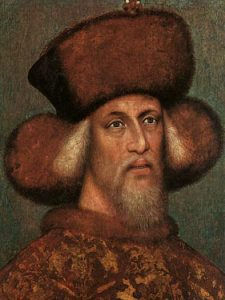(Pisa 1395- Naples 1450)
Antonio di Puccio Pisano, known as Pisanello, was an Italian painter and medallist. He trained in Verona alongside Stefano da Zevio and Gentile da Fabriano, whose courtly manner formed the basis of his style. Pisanello pushed the meticulous calligraphy of forms, the elegant precision of silhouettes, and all the whims of a bold and penetrating realism to the limit.
In Verona, he painted his masterpieces: The Madonna of the Quail and The Annunciation (fresco in San Fermo Maggiore) and, above all, the fresco of Sant Anastasia: Saint George Saving the Princess of Trebizond (1436). In 1425, he traveled to Venice with Gentile da Fabriano, and then went to Rome to finish the frescoes that the latter had left unfinished in San Giovanni in Laterano (1431-1433, destroyed in the 17th century).
Pisanello's first medal is that of John VII Palaiologos, executed in Ferrara in 1438. He was then called to the main courts of Italy - Mantua, Milan, Rimini - where he created medals with grand effigies of the princes of his time: Lionello d'Este, of whom he also made a painted portrait, Louis of Gonzaga, Philip Maria Visconti, and Sigismund Malatesta.
He was also in Naples and engraved medals of Alfonso the Magnanimous, for whom he designed a triumphal arch project. Pisanello elevated the art of the medal to a higher level through allegorical invention, the balance of compositions, and the broad and frank treatment of metal. He was an extraordinary draftsman, especially of animals.
Antonio di Puccio Pisano, known as Pisanello, was an Italian painter and medallist. He trained in Verona alongside Stefano da Zevio and Gentile da Fabriano, whose courtly manner formed the basis of his style. Pisanello pushed the meticulous calligraphy of forms, the elegant precision of silhouettes, and all the whims of a bold and penetrating realism to the limit.
In Verona, he painted his masterpieces: The Madonna of the Quail and The Annunciation (fresco in San Fermo Maggiore) and, above all, the fresco of Sant Anastasia: Saint George Saving the Princess of Trebizond (1436). In 1425, he traveled to Venice with Gentile da Fabriano, and then went to Rome to finish the frescoes that the latter had left unfinished in San Giovanni in Laterano (1431-1433, destroyed in the 17th century).
Pisanello's first medal is that of John VII Palaiologos, executed in Ferrara in 1438. He was then called to the main courts of Italy - Mantua, Milan, Rimini - where he created medals with grand effigies of the princes of his time: Lionello d'Este, of whom he also made a painted portrait, Louis of Gonzaga, Philip Maria Visconti, and Sigismund Malatesta.
He was also in Naples and engraved medals of Alfonso the Magnanimous, for whom he designed a triumphal arch project. Pisanello elevated the art of the medal to a higher level through allegorical invention, the balance of compositions, and the broad and frank treatment of metal. He was an extraordinary draftsman, especially of animals.


